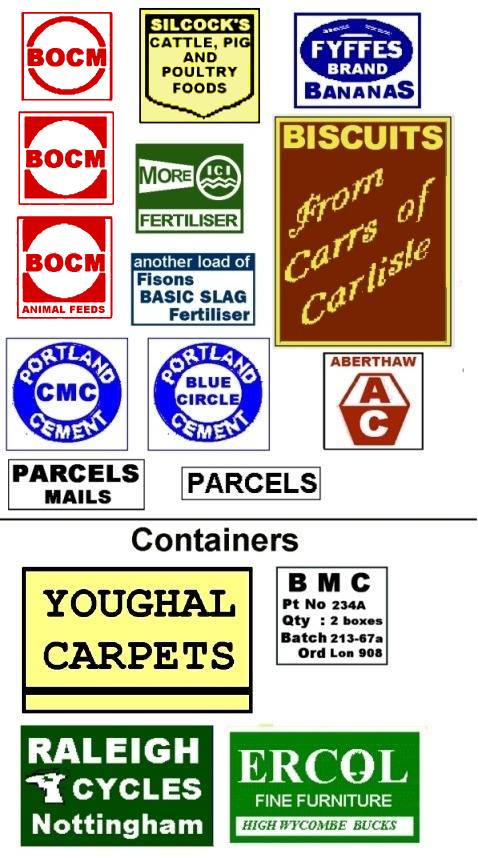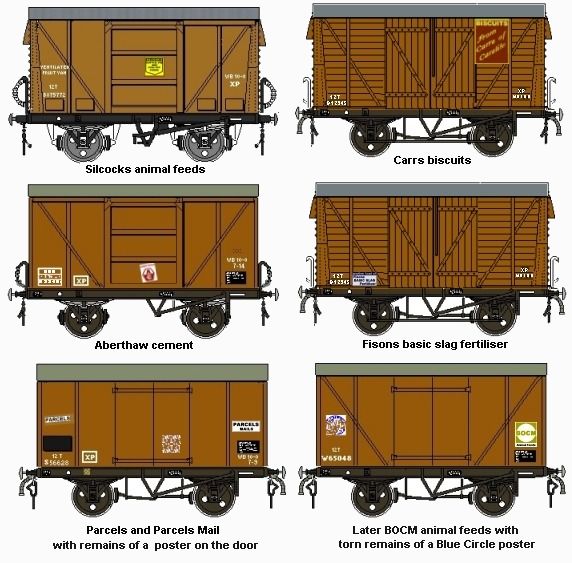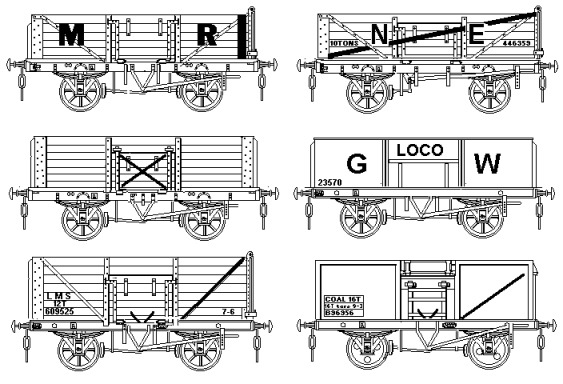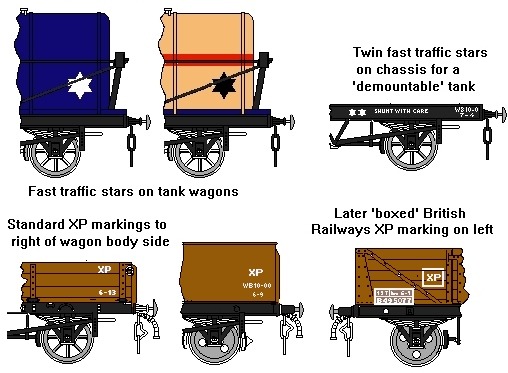
| Return to index page |
Livery Information - Introduction.
NB The colours used were obtained by sampling colour pictures, they may however vary from the true colour, use as a rough guide only
Most N Gauge modellers favour either the post 1923 'Big Four' era or the
early years of British Railways, with a growing interest in the more recent
British Rail and privatised eras. I have therefore concentrated on the period
1923 to date in the following discussion.
In the pre-Grouping era there were a
great many companies, often small, and I have included livery details and some
general notes on the more significant companies involved in the 1923 Grouping
in Appendix Two.
Most railway stock runs for about seven or eight years between re-paints, if the vehicle was not often used and hence not serviced this could stretch to ten or even fifteen years. As a result the older pre-1923 liveries were still seen as late as the 1940's in a few cases. It should be noted that even with railway company owned rolling stock there was considerable movement of stock outside a home companies area, so all the following liveries would have been seen in any area of the country, with the exception of `departmental wagons' (used by the railway company engineers) and some very specialised stock.
There are several categories of `goods' stock, ranging from the simple open wagon to specialised items such as fish vans and refrigerated vans. There is also a category referred to as `non passenger coaching stock', built to operate at high speeds and equipped to couple up to passenger coaches (examples include milk tanks and milk churn vans, fish vans, some fruit vans etc.). These unusual types were often distinguished by body colour, for example refrigerated vans were often painted white whilst the non passenger coaching stock would generally be painted in a simplified version of the company's passenger coach livery.
Wooden bodies were painted mainly as protection from the weather, the colours used were from a limited range of lead based paints determined by the paint technology of the period. Most companies opted for grey or reddish brown, although there was considerable variation on the shade or hue. Touching up the worst areas on a wagon, known as `patch painting', was common practice and repairs were not always painted immediately. Hence with wooden bodied vehicles it was not uncommon to see unpainted planks in the side or end. The best I have come up with for unpainted wood is Humbrol Dark Earth mixed with a very light grey based on their matt black and white.
The insides of the wagons are usually unpainted and 'natural wood'
colour, with some staining from past cargo. Obviously coal wagons would become
blackened from the load, and to a lesser extent so would the general
merchandise wagons, cargo such as bagged `lamp black' (basically soot) would
undoubtedly stain the planking for example. Cargo such as chalk rock would also
have stained the body of wagons (in some cases virtually obliterating the
markings) and steel wagons would of course rust.
As far as I am aware the
railway companies left the insides of wooden stock unpainted. Steel bidied wagons were painted inside and out in the body colour, one exception
being steel hoppers, which often had a black bitumen based coating on them to
prevent rusting (this coating was not applied to non-hopper steel open wagons).
The floors of the wooden bodied china clay wagons built by the GWR had a three piece zinc sheet laid longitudinally to protect them from the wet clay and wooden bodied sand wagons often had mild steel sheeting internally to prevent the sand from leaking out between the planks. Similarly the wagons used for tarred stone chippings were fitted with a sheet metal floor, the insides of these wagons would be stained black but the floor would have rust and shiny metal streaks.
One sometimes sees pictures of cattle wagons with white interiors and white stains on their sides caused by `lime washing' the insides of the wagons as a way of disinfecting them. The interior of these wagons should be all white and the liquid leaked out between the planks as well as through the built-in openings. There would be patches of white all over the body but mainly where there were gaps such as the openings at the bottom and around the open upper sides. This practice was banned in the 1920's, so the stains should not appear on Big Four or British Railways stock.
Prior to the Big Four era several companies painted the ends of their brake vans vermilion red, matching the loco buffer beams (see also Freight Locomotive Liveries below).
It was common practice for staff in goods yards to chalk the destination of a particular wagon or, more commonly, van on the sides of the vehicle. At a larger goods depot a rake of wagons would be formed up, each going to a specific destination. In transit the wagon would re routed according to the instructions on the wagon label but at the depot the staff needed to know where an individual vehicle would be going. This was in part because of the large amount of `sundries' traffic, i.e. goods shipped constituting less than a full wagon load, a single barrel of nails for a country hardware shop or someone's personal belongings. These chalk markings remained a characteristic feature of railway stock into the 1970's and early 80's. Some companies, including British Railways, provided small `chalk boards' on the side of some stock, or a painted black `patch' for this, but the photographic evidence suggests that the markings were seldom confined to these areas.
In addition there were the colourful 'traders labels' applied to rolling stock. This practice appears to have caught on in the 1930's (when suitable latex based glues were developed). The BK container supplied by Peco has a rectangular plate in the upper corner of the side provided specifically for such a label. These were softwood panels, suited to the adhesive used for the labels, and seem to have appeared in the later 1930's. One occasionally sees railway company liveried containers from the pre-war period bearing the remains of a stuck-on label, the examples I have seen must have had paste or glue applied round the edges only, where they have been removed the mark left is a rectangle of scraps of white (these were not common however). BR era examples, where the labels had been applied to the sides of wagons and vans, showed a rectangular patch of scraps of white strips where the label had been removed. These traders labels were often quite colourful, and in early British Railways days provide a welcome splash of colour on an otherwise rather drab scene.
British Railways staff also used stick on labels, for example when a goods van was used for 'parcels' traffic it had a white paper label with the word PARCELS in about 3 inch (7.6 cm) high lettering, with the word MAILS underneath it in 4 or 5 inch (10-12 cm) high lettering.
My own labels are a mixture, some are small pieces cut from the wrapper type labels on food jars whilst some are copied from real labels. The snag with the latter is that my printer cannot print fine enough so I print them out at 400 percent and reduce them on a colour photocopier. Unfortunately the printers reluctance to try using thin paper in case it messes up the machine means they end up rather thicker than I would like (sanding down the reverse side helps but they are still too thick). The sketch below shows some of my labels, I cannot be sure of the colours on some but I believe the Silcocks, BOCM and Blue Circle examples are definitely correct.
Fig ___ Examples of traders labels 
It is worth noting that some vans, notably seasonally affected fruit vans, were often used for other traffic. In Dave Larkin's book British Railways Standard Freight Wagons (see Bibliography) there is a picture of a British Railways fruit van bearing labels for both British Railways Parcels and Blue Circle Cement. When removed these labels left traces on the wagon side, usually just a light coloured rectangular 'patch' but sometimes a corner of the label might be left stuck to the vehicle side. The sketches below show typical placings taken from photographs.
Fig ___ Stick-on trader's labels 
The Railway Clearing House or RCH had the job of keeping track of wagons when they travelled onto other company systems and issued regulations regarding markings. As already discussed under Control one requirement was for a cast metal plate identifying the wagon by number and also the railway company on whose rails it was normally 'at home'. These cast plates, called 'registration plates' were introduced in the late 1830's, the railway companies favoured them over simple painted markings as they enabled the identification of a wagon after a fire and they could specially shaped to indicate vehicles which should be fitted with oil filled axle boxes. Registration plates were usually painted black, sometimes with the lettering picked out in white, and were always bolted to the chassis so that replacing a broken body plank would not remove them. The rules required the registration plate to be bolted toward the left hand end of the sole bar but some were fitted close to the middle of the chassis. The wagon builder would also mount a metal plate on the wagon, these were typically six inches long by four inches high (15cm by 10cm) and they tended to end up somewhere about the middle of the solebar. Some companies never bothered painting on wagon numbers, relying instead on the 'registration plate'. The GWR tried small cast metal plates bearing the company initials to save on painting costs and the Great Central used cast plates on their permanent way 'departmental' stock but painted lettering was the norm by the 1920's.
Another RCH requirement was a cast metal plate on the doors of gunpowder wagons giving instructions on dealing with these wagons, these plates were also fitted to British Railways built gunpowder vans.
In the 1930's the LNER introduced cast metal plates for fruit and fish vans as described below.
Fig ___ Cast plates used on wagons and vans 
Basic Lettering of Rolling Stock
Regarding the lettering of stock certain information was necessary for operational reasons, this includes the `tare' weight (which is the weight of the empty wagon), the load (how much the wagon was designed to carry), the wagon number and the owning company. In some cases, notably with drop-sided wagons but also sometimes on vans and standard wagons, the vehicle number was painted on the ends as well as or instead of the sides, so it could be seen whilst the vehicle was being loaded. The Southern Railway was slightly unusual in having most of the details of their cattle wagons marked on the ends, this was a holdover from pre-grouping days when washing livestock wagons out with lime tended to remove or stain the paint on the sides.
In the middle of the nineteenth century, as the railways began to join up into a network, railway companies began painting their initials on the sides and sometimes on the ends of wagons and vans. The size of the lettering generally started off quite small (four to six inches, 10-15 cm) but by the turn of the century most companies had settled on quite large initials, typically eighteen to twenty four inches (46-61 cm) high. These large letters remained pretty much standard, being applied to wagons and vans up to the latter part of the 1930's. Large lettering was not universal however, for example the Somerset & Dorset Joint Railway and the Midland & South Western Junction Railway both used lettering only some 6 or 9 inches (15-20cm) high on their stock.
Some details seem to have been common practice, the tare weight of the wagon was usually to be found on the lower right of the body side or on the solebar, sometimes in an italic script and often rather small (two to four inches (5-10cm) high). The load, in tons, was marked on the lower part of the body side but some had this on the left and others on the right, generally this was in lettering four to six inches (10-15cm) in height. Railway owned stock had the number painted on the side, usually to the lower left but on sliding door vans it was often on the door, the numbers were typically four to six inches (10-15cm) in height. Company loco coal wagons usually had the word LOCO or LOCO COAL in white, towards the centre upper side in lettering generally about a foot (30 cm) high.
On mineral wagons fitted with bottom doors the position of these was indicated by two thin white lines, forming a \/ with an open bottom, painted on the side of the wagon about twelve inches (30cm) high. This again was a pre-grouping marking, used by the Midland Railway and others and adopted as standard by the Big Four and some private owners. After about 1925 all mineral wagons fitted with an end-door were marked with a diagonal white line on the side, rising to the door end of the wagon. This replaced various schemes, including diagonal lines, and there was some variation between company styles and between individual wagons from a single company, the line might run from the lower opposite corner of the wagon or just from the bottom of the side door. Mineral wagons on which the side doors were broken usually had the offending door marked with a large white X.
Fig ___ Special markings on mineral wagons 
In 1936 the LMS changed to using small lettering, concentrated in the lower left and right corners of the vehicle body. This was introduced as an economy measure, these markings could be applied without a step-ladder and used less paint. In 1937 the `Big-Four' agreed to adopt a basically similar standard layout for goods stock marking. This meant that staff would know where to find important information on wagons from another company. The lettering style in all cases was to be `sans serif' plain script.
Under this system the wagon number was painted about five inches (12cm) high on the left hand end of the vehicle, usually on the bottom plank. Above this appeared the payload in the form `10 T' some four inches (10cm) high, and above that the company initials (LMS, LNER, GWR or SR) five inches (12cm) high.
To the lower right, sometimes on the solebar but more commonly on the bottom plank, would usually be found the tare of the wagon in the form `6.2' (tons and hundredweight's), or sometimes `6.13.O' (tons hundredweight's and quarters). This was in lettering between three and six inches high (7.5-15cm), varying within individual companies stock. From about 1938 the wheel base of the vehicle in feet and inches in the form `WB-1O-OO' was often painted above the tare weight.
On stock considered suitable for operating in express goods trains the Big Four companies settled on the marking `XP' towards the right hand end of the body side (this replaced the various markings previously applied by the pre-grouping companies to identify `fitted' stock). Tank wagons differed in using a six pointed star, introduced in 1913, to indicate they were suitable for use on 'fast traffic' runs (that is for trains with average speeds of 35 miles per hour and stops at intervals of no more than 40 miles). It was sometimes, rather optimistically and incorrectly, applied to some very old wagons such as a rectangular tank wagons on wooden chassis with a nine foot wheelbase, however this may have been simply for the purposes of publicity photographs. Unfitted tank wagons, many of which survived in to the 1960s and a few into the 1970s, could have a star on them but I think this was confined to 10 and 12 foot wheelbase tanks (not all of which had them). The star was 2 feet across and either black (on white or yellow tanks) or white (on red or black tanks). Some tank vehicles had two stars, indicating they could run at higher speeds (including parcels trains), and a very few had three indicating they could run in passenger trains (I believe this may have included a requirement for a steam heating through-pipe). I have only seen a single four wheeled tanker with three stars (a multi-compartment beer tank wagon - see Kit Bashing section, 'Unusual tank wagons') but the six wheeled chassis used for road-rail milk tanks all had a three star rating. Where the body was removable (container wagons, road-rail tank trailer wagons and de-mountable tank wagons) the XP or star was placed on the chassis (some demountable tanks had the stars painted on them but the marking was always shown on the chassis).
Fig ___ Fast traffic markings 
To qualify as `fast traffic' general goods stock had to have a chassis with a minimum of 10 foot wheelbase, fitted with a vacuum brake and oil axle boxes (fruit vans being a typical example). I believe tank wagons could be marked with the star even if they did not have the vacuum brake fitted.
In the early to mid 1930's the companies seem to have agreed on some standardisation of container liveries, with the general adoption of the reversed `Z' layout on furniture containers, as shown on the Peco GWR container.
During the Second World War the code names for railway rolling stock were standardised and the new names were painted on the vehicles as they passed through the workshops. This change was gradual however, the extingencies of war meant that little painting was actually done and often replacement planks were left unpainted after repairs. One of the changes introduced during the war was a new marking for gun powder vans, consisting of a black disk containing a white letter G surrounded by a white circle. This was again applied to railway company wagons as they passed through the paint shops and so was not universal. This branding was abandoned after the war, the vans being marked 'GUNPOWDER VAN' as shown in Fig ___.
Fig___ LNER Gunpowder van showing wartime marking 
Probably the best way to deal with the company liveries is to mention the basic rules of each company and exemplify specific layouts in simple diagrammatic form. It should be noted that the paint was mixed as required and so there would be some variation in the final body colour achieved between various workshops. Also the paint faded in use, resulting in variations between individual wagons and 'patch painting', that is touching up the worst areas, became common in the 1930's as an economy measure.